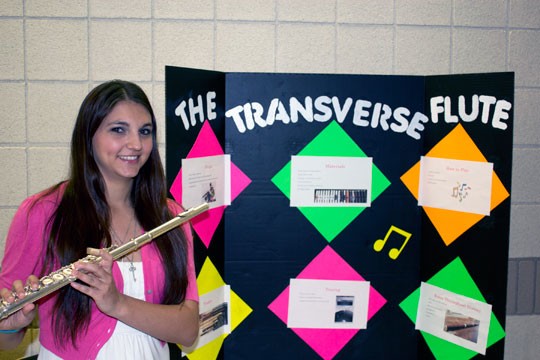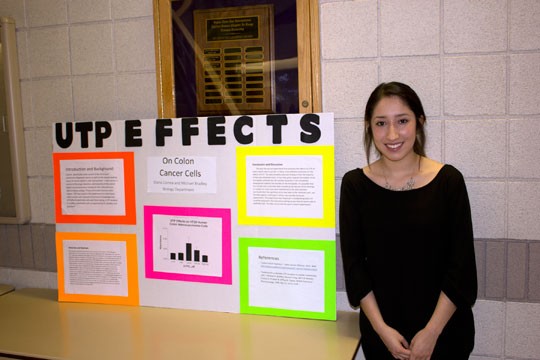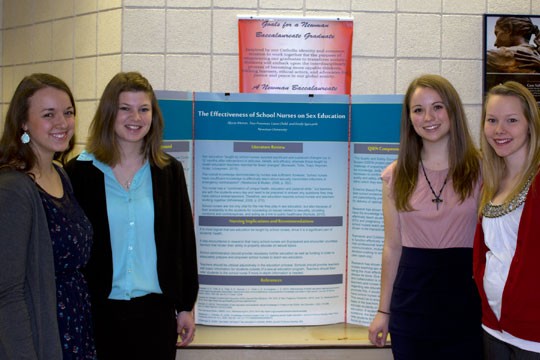More than 100 students had the opportunity to show what they have learned during their academic career at Newman University at Scholars Day, which took place from 10 a.m. to 3 p.m., May 8 in Eck Hall on the Newman campus.
The event featured the results of student research on a wide variety of topics, and included Newman faculty members who reviewed and appraised the students’ work, asked questions to probe deeper into the students’ knowledge of their topics, and offered comments and praise on the quality and outcomes of their research.
Scholars Day is the presentation of research projects undergraduate students have done as part of the requirements to earn a bachelor’s degree at Newman University. Each student must identify a faculty mentor, who agrees to approve and guide the student through some kind of research that reflects the student’s major field of study and personal interest. In many cases the projects are done to meet the requirements of the Newman Studies Program, a unique approach to the “core curriculum” developed at Newman, which is also required to earn a degree.
Based in large part on the university’s namesake Blessed John Henry Cardinal Newman’s The Idea of a University, which is recognized as a standard for liberal arts higher education, the NSP focuses on the elements of active learning, critical thinking, interdisciplinarity and connectivity to help students go beyond rote memorization and become analytical thinkers. The program emphasizes reading and writing across all academic disciplines, as well as team-taught courses, interdisciplinary learning communities, project-based and role-playing learning and other activities designed to empower students to make connections, consider different perspectives and draw conclusions.
The research students perform for their projects are often done in an NSP course or research-oriented class in the student’s major. Students may collaborate on projects, and presentation of the research may take a variety of forms, including formal academic panels, poster sessions, creative readings or exhibits, video compilations or other means. Scholars Day is presented at the end of each fall and spring semester.
Students’ projects included an array of subjects. Among the many presentations were “The Effects of Propionibacterium Acnes on Colonocytes,” “Should Adolescents be Allowed to Make Life or Death Decisions?” “The Prevalence of Opioid Abuse/Dependence of VA Chronic Pain Patients,” “Are Companies Living Up to the Catholic Standard?” “Rainforest Deforestation,” “Are We Zombies?” and “Homeschool and Social Development.”
Students spoke on their experience doing the projects and the effects it had on them academically and personally.
“It was great having the team to work with and learning what it takes to be a good nurse,” said senior nursing student Clarissa Leidholt, whose project was entitled “Nursing Factors Affecting Medication Errors.”
“I didn’t realize there are so many different [art] projects going on to bring awareness for certain issues, like AIDs, cancer and ADHD,” said senior biology and pre-med major Jarrod Flax. He, along with fellow student Brianna Rivera, presented “By the People, For the People: A Museum of Social Justice,” a project that explored interconnections between beauty and social justice. “They’re starting to make artwork for defibrillators just because not many people know how to use them so they’re scared about it. It was amazing to be able to see how art is being used. We learned a lot throughout the process.”
Many students also learned the benefits that come with the Newman Studies Program.
“I think the NSP courses are good because they open your eyes to what you are not necessarily being open to,” said Rivera, who worked with Flax on the “Museum of Social Justice” project. “We were in Dallas, and Jarrod and I were noticing artwork everywhere. And it was ‘I wonder if that one has a story behind it’ like we learned in class, and I wondered what purpose this piece of artwork was. So, it was impactful in a more personal level.”
Senior biology major Danielle Eller, who has played the flute for 13 years, studied how flutes and other music instruments are made and how they work to produce various sounds. Her project, “The Transverse Flute,” grew from the NSP class “Good Vibrations.”
“I wasn’t sure how this class would relate to my major, but I learned things about the flute I didn’t know before,” Eller said. “There’s a lot of physics involved in making the different pitches – a lot more science than I thought.”





